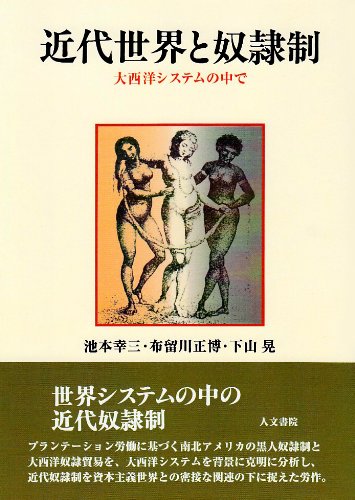12 0 0 0 OA 15, 6世紀ポルトガル王国における黒人奴隷制 (1) ―近代奴隷制の歴史的原像―
- 著者
- 布留川 正博 Masahiro Furukawa
- 出版者
- 同志社大学経済学会
- 雑誌
- 經濟學論叢 = Keizaigaku-Ronso (The Doshisha University economic review) (ISSN:03873021)
- 巻号頁・発行日
- vol.40, no.2, pp.57-84, 1988-11-30
7 0 0 0 IR 大西洋奴隷貿易の新データベースの歴史的意義 (嶋田巧教授定年退職記念号)
- 著者
- 布留川 正博 Masahiro Furugawa
- 出版者
- 同志社大学商学会
- 雑誌
- 同志社商学 (ISSN:03872858)
- 巻号頁・発行日
- vol.66, no.6, pp.1073-1090, 2015-03
4 0 0 0 OA 15, 6世紀ポルトガル王国における黒人奴隷制 (2) ―近代奴隷制の歴史的原像―
- 著者
- 布留川 正博 Masahiro Furugawa
- 出版者
- 同志社大学経済学会
- 雑誌
- 經濟學論叢 = Keizaigaku-Ronso (The Doshisha University economic review) (ISSN:03873021)
- 巻号頁・発行日
- vol.40, no.3, pp.80-102, 1989-02-28
3 0 0 0 IR 15,6世紀ポルトガル王国における黒人奴隷制--近代奴隷制の歴史的原像-1-
- 著者
- 布留川 正博
- 出版者
- 同志社大学経済学会
- 雑誌
- 経済学論叢 (ISSN:03873021)
- 巻号頁・発行日
- vol.40, no.2, pp.p249-276, 1988-11
3 0 0 0 IR 15,6世紀ポルトガル王国における黒人奴隷制--近代奴隷制の歴史的原像-2-
- 著者
- 布留川 正博
- 出版者
- 同志社大学経済学会
- 雑誌
- 経済学論叢 (ISSN:03873021)
- 巻号頁・発行日
- vol.40, no.3, pp.p598-620, 1989-02
1 0 0 0 近代世界と奴隷制 : 大西洋システムの中で
- 著者
- 池本幸三 布留川正博 下山晃著
- 出版者
- 人文書院
- 巻号頁・発行日
- 2003
1 0 0 0 奴隷貿易禁止とアフリカ分割への道 (特集 奴隷制の歴史的考察)
- 著者
- 布留川 正博
- 出版者
- 歴史科学協議会
- 雑誌
- 歴史評論 = Historical journal (ISSN:03868907)
- 巻号頁・発行日
- no.846, pp.48-59, 2020-10
1 0 0 0 OA エリック・ウィリアムズの「衰退理論」再考―奴隷貿易廃止期における英領西インドの経済―
- 著者
- 布留川 正博 Masahiro Furugawa
- 出版者
- 同志社大学経済学会
- 雑誌
- 經濟學論叢 = Keizaigaku-Ronso (The Doshisha University economic review) (ISSN:03873021)
- 巻号頁・発行日
- vol.54, no.4, pp.310-333, 2003-03-20
- 著者
- 布留川 正博
- 出版者
- 社会経済史学会
- 雑誌
- 社会経済史学 (ISSN:00380113)
- 巻号頁・発行日
- vol.68, no.3, pp.463-465, 2002-09-25 (Released:2017-08-14)
1 0 0 0 IR イギリスにおける年季奉公人制の廃止, 1834-38年
- 著者
- 布留川 正博
- 出版者
- 同志社大学
- 雑誌
- 經濟學論叢 (ISSN:03873021)
- 巻号頁・発行日
- vol.64, no.3, pp.593-621, 2013-03
論説(Article)1834年8月1日に発布されたイギリスの奴隷制廃止法では、黒人たちは奴隷身分からは解放されたものの年季奉公人として元の奴隷主の下で週45時間働くことを強いられた。野外奉公人は6年、非野外奉公人は4年の年季であった。奉公人は、この制度は奴隷制と変わらないばかりか部分的にはそれよりも悪くなったと感じていた。この制度を監視する役割を担った有給判事は、プランターと奉公人とのあいだの紛争処理に際して概してプランター側についた。反奴隷制協会および新たに組織された黒人解放中央委員会は、奉公人に対する鞭打ちや虐待などの事実を暴露し、年季奉公人制反対のキャンペーンを繰り広げた。その結果、各植民地議会は野外奉公人も含めて1838年8月1日に年季奉公人制を廃止することを決議した。The Act for the Abolition of Slavery, which was promulgated on August 1, 1834, in all British dominions, compelled blacks to work for 45 hours per week, under their former owners. This system was called "apprenticeship"; the apprenticeship term for praedial laborers was six years, while that of non-praedial laborers was four. The stipendiary magistrates—who had been appointed by the imperial government—tried to oversee the system, but they were inclined to side with the planters. Several cases of flogging and other abuses against apprentice laborers were reported by the Anti-Slavery Society. The Society undertook many campaigns supporting the abolition of apprenticeship, and ultimately, all colonial assemblies resolved on August 1, 1838 to completely abolish the system.
1 0 0 0 IR イギリスにおける奴隷制廃止運動 : 漸進的廃止から即時廃止へ
- 著者
- 布留川 正博
- 出版者
- 同志社大学
- 雑誌
- 經濟學論叢 (ISSN:03873021)
- 巻号頁・発行日
- vol.62, no.1, pp.1-33, 2010-09
論説(Article)1807年にイギリスで奴隷貿易が禁止されて以降、奴隷貿易廃止運動家たちはアフリカからもはや新たな奴隷が入ってこない以上、プランターは現有の奴隷の状態を改善していくだろうと期待していた。しかし、1820年代初めになっても奴隷の状態は一向に改善していなかった。そこで1823年に奴隷制廃止を目的とする反奴隷制協会がロンドンで結成された。多くのイギリス人がこの目的達成のための議会請願運動に参加した。その結果、1833年に奴隷制廃止法が制定された。本稿は、奴隷制廃止に至る過程を関連する報告、小冊子などを使って分析したものである。After the abolition of slave trade throughout the British dominions in 1807, most of the abolitionists expected the planters to willingly end the practice of slavery because they could no longer import fresh slaves from Africa. However, even in the early 1820s, this inhuman practice continued in the British West Indies. In light of this, the Anti-Slavery Society was established in London in 1823. Many British people petitioned for immediate emancipation, and as a result, the Emancipation Act was passed in 1833. This paper analyzes the process of the emancipation of British slaves by using various reports, tracts, and other data sources.
1 0 0 0 IR イギリスのアボリショニズムとシエラ・レオネ植民地 (小森瞭一教授古稀記念論文集)
- 著者
- 布留川 正博
- 出版者
- 同志社大学
- 雑誌
- 經濟學論叢 (ISSN:03873021)
- 巻号頁・発行日
- vol.57, no.4, pp.755-783, 2006-03
シエラ・レオネ植民地は、イギリスの奴隷貿易・奴隷制廃止運動が行なわれている時期に西アフリカにおける自由管区として創設された。クラパム派のアボリショニストはシエラ・レオネ入植計画を支援し、かつ、推進した。在英黒人やノヴァ・スコシアの黒人、ジャマイカのマルーン出身の人々のようなさまざまな黒人がそこに運ばれてきた。彼らは、食糧不足や熱病にもかかわらずそれぞれのコミュニティを形成した。1807年の奴隷貿易禁止法以降、非合法貿易の犠牲になった多くのアフリカ人がシエラ・レオネで解放された。そのほとんどはシエラ・レオネに留まったが、一部は1840年代になると年季奉公人労働者として英領西インドに運ばれた。Sierra Leone colony in West Africa was founded in the era of British abolitionism as a Province of Freedom. Abolitionists of Clapham Sect supported and promoted the Project of Sierra Leone Settlement. Various black people such as blacks in England, Nova Scotia, and Maroons in Jamaica were transported there. They formed each Community against a shortage of provisions and a fever. After An Act of the Abolition of the Slave Trade in 1807, many Africans who were the victims of the illegal trades, were emancipated in Sierra Leone. Most of them settled there, but some of them were transported into the British West Indies as indentured labourers in 1840s.

